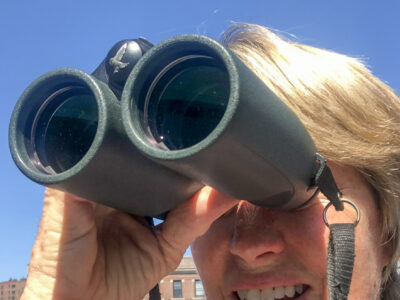
One of the most frequently asked questions by birdwatchers – either novice or those who want to upgrade their binoculars – is “what binos should I buy?” This is a subjective and highly personal decision to make, but there are ways to narrow down the choices. Here are some things to consider:
1 – Price – you can spend from $50 to nearly $3000 on a pair of binos. What sets them apart is primarily the quality of the optics. But that doesn’t necessarily mean that the only good pair of binoculars for birdwatching is the most expensive one. There are less expensive binoculars that deliver a good quality image, but perhaps not all the rest of the experience. Get the best pair of binoculars you can afford as this is an investment that will pay off in long-term reliable viewing performance, and eliminate the need to constantly upgrade your binos. A really good pair can last you decades.
2 – Magnification and Field of View – For birdwatching, you need a pair of binoculars that can sufficiently magnify the bird so you can see the field marks, and also give you a wide field of view of the area so you can more easily find the bird. When you purchase binoculars you will be given two numbers representing magnification x field of view. I have 10X42 which means the magnification of the lenses is 10X what I see with my eyes. It also means there is just a little less light than if I had purchased 8X binoculars, but the image is also a little less magnified. And the lenses through which I am looking are 42mm – they have a field of view that is wide enough so I can more easily find the bird. Most birders buy 7,8, or 10 magnifications and 32 or 42 field of view.
The combination of the magnification and field of view is important. As an example, the compact binoculars that were attractive and easy to put into a pocket while hiking turned out to be difficult to find birds. The lenses had great optic quality but not wide enough field of view (they were 10×25), and when looking in a forest I had difficulty determining where the bird was – even if I could see it with my eyes. I know I’m not alone in this inability to use compact binos, although many people prefer the tiny ones as they are portable. But there is a trade-off.
3 – Clarity, Color, and Light – The optics have to be sharp enough that you can easily see a crisp view of the bird, and they need to be able to perform in low light. Not every bird is a shorebird on a mudflat in bright sunlight. And for those less co-operative forest birds active at first light, or owls at dusk, you are going to want enough light sensitivity that you can see the bird and some color in low light. This is something that some of the lower-end binos may not deliver. And remember that the higher the magnification, the less light that goes into the lens.
4 – Weight – If you are going to be carrying these around your neck all day, you need to be sure you can manage it. Binoculars are getting smaller and lighter in weight, so the larger magnification is becoming easier to hold and carry around. When you are comparing models, first make sure they are not too heavy to handhold without shaking. If that is not an issue, but they seem too heavy to carry around your neck all day, then purchase a harness that distributes the weight more evenly across your shoulders rather than around your neck.
5 – Other – This catchall category encompasses things like waterproofing, warranties, feel, etc.. If the binos are not waterproof, don’t buy them. You will find yourself in inclement weather and receiving ocean spray more often than you imagine at the moment, and most binoculars worth buying now are both waterproof and fog proof. And it’s worth looking at the warranty, as if you are a dedicated birder you will find your binos are going to be needing servicing from time to time. Also, it’s best to hold the binoculars and test them out – even if it’s just in the store. If the grip doesn’t seem right, don’t buy them. You may be holding them for hours and it will be uncomfortable.
The points above are a start, but which models to start with? Check out this article from Audubon that reviews binoculars in several price categories. Once you have decided how much you want to spend, take a look at the recommended choices and think about the above points. Then visit a store in your area that sells binos and try out the ones that got the reviews you like and meet the requirements you need. Then take them for a spin before migration starts so you are ready to do some serious bird spotting.
Using the 10×42’s; Photo Credit: Deborah Rivel